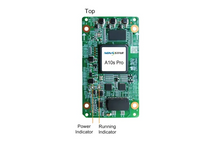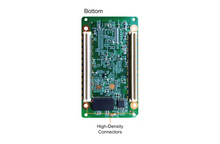Armor Series LED Receiving Card is the high-end mini receiving card series of NovaStar with small size and full functions. Designed with high-density connectors, anti-looseness effect and dust proof function, it is quite stable and reliable. The board card has integrated network transformers to simplify design for users. A board card can suit all kinds of applications.
Description
Novastar Armor Series LED Receiving Card A10s Pro
Novastar Receiving Card Models:
Armor Series Receiving Card
A10S Pro Receive Card
A10S Plus Receive Card
A9S Receive Card
A9 Receive Card
A8S Receive Card
A8 Receive Card
A7S Receive Card
A7 Receive Card
A5S Receive Card
A5 Receive Card
A4S Receive Card
Standard MRV Series Receiving Card:
MRV206 Receive Card
MRV266 Receive Card
MRV366 Receive Card
MRV328 Receive Card
MRV316 Receive Card
MRV308 Receive Card
MRV336 Receive Card
DH Series Receiving Card
DH436 Receive Card
DH418 Receive Card
The A10s Pro is a fully-featured high-end small receiving card developed by NovaStar. A single A10s Pro supports resolutions up to 512×512@60Hz. It supports the exclusive Dynamic Booster, Full-Grayscale Calibration and Image Booster technologies of NovaStar. The Dynamic Booster can significantly improve the display contrast. The FullGrayscale Calibration can make the display brightness and chroma more uniform at different grayscale levels. The Image Booster can precisely calibrate the display color gamut and grayscale and improve the grayscale by 64 times. The A10s Pro also supports the pixel level brightness and chroma calibration, quick adjustment of dark or bright lines, low latency, 3D, individual gamma adjustment for RGB, image rotation in 90° increments, image rotation at any angle, and HDR functions, greatly improving the brightness, grayscale and color performance from every aspect and offering users an ultimate visual experience with a uniform, smooth and lifelike image. The A10s Pro uses high-density connectors for communication to limit the effects of dust and vibration, resulting in high stability. It supports up to 32 groups of parallel RGB data or 64 groups of serial data (expandable to 128 groups of serial data). Its reserved pins allow for custom functions of users. Thanks to its EMC Class B compliant hardware design, the A10s Pro has improved electromagnetic compatibility and is suitable for various on-site setups that have high requirements.
Improvements to Display Effect
- Dynamic Booster Significantly improve the display contrast and image details for better visual experience and effectively control and lower the display power consumption.
- Full-Grayscale Calibration Each grayscale level of the input source has its own unique calibration coefficients, which can achieve uniform display brightness and chroma in high brightness, medium grayscale, and low grayscale at the same time
- HDR function HDR10 and HLG are supported. Work with the sending card that supports the HDR function to correctly parse the HDR video source and faithfully reproduce the original brightness range and color space, allowing for a more lifelike image.
- Image Booster The Image Booster has the following 3 functions that improve the display effect (the actual effect depends on the driver IC) from different dimensions.
- Pixel level brightness and chroma calibration Work with NovaStar’s high-precision calibration system to calibrate the brightness and chroma of each pixel, effectively removing brightness differences and chroma differences, and enabling high brightness consistency and chroma consistency.
- Quick adjustment of dark or bright lines The dark or bright lines caused by splicing of modules or cabinets can be adjusted to improve the visual experience. The adjustment is easy and takes effect immediately
- Low latency The latency of video source on the receiving card end can be reduced to 1 frame (only when using modules with driver IC with built-in RAM).
- 3D function Working with the sending card that supports 3D function, the receiving card supports 3D output
- Image rotation in 90° increments The display image can be set to rotate in multiples of 90° (0°/90°/180°/270°).
- Individual gamma adjustment for RGB
- Image rotation at any angle Working with SmartLCT and the MCTRL R5 LED display controller, the receiving card supports image rotation at any angle.
Improvements to Maintainability:
- Automatic module calibration After a new module with flash memory is installed to replace the old one, the calibration coefficients stored in the memory can be automatically uploaded to the receiving card when it is powered on.
- Quick uploading of calibration coefficients Upload the calibration coefficients quickly to the receiving cards to improve efficiency.
- Module Flash management For modules with flash memory, the information stored in the memory can be managed. The calibration coefficients and module ID can be stored and read back.
- One click to apply calibration coefficients in module Flash For modules with flash memory, when the Ethernet cable is disconnected, users can hold down the self-test button on the cabinet to upload the calibration coefficients in the memory of the module to the receiving card.
- Mapping function The cabinets can display the sending card number, Ethernet port number and receiving card number, allowing users to easily obtain the locations and connection topology of receiving cards.
- Setting of a pre-stored image in receiving card The image displayed during startup, or displayed when the Ethernet cable is disconnected or there is no video signal can be customized.
- Temperature and voltage monitoring The receiving card temperature and voltage can be monitored without using peripherals.
- Bite error detection The Ethernet port communication quality of the receiving card can be monitored and the number of erroneous packets can be recorded to help troubleshoot network communication problems. NovaLCT V5.2.0 or later is required.
- Status detection of dual power supplies When two power supplies are used, their working status can be detected by the receiving card.
- Firmware program readback The receiving card firmware program can be read back and saved to the local computer. NovaLCT V5.2.0 or later is required.
- Configuration parameter readback The receiving card configuration parameters can be read back and saved to the local computer.
- LVDS transmission (dedicated firmware required) Low-voltage differential signaling (LVDS) transmission is used to reduce the number of data cables from the hub board to module
- increase the transmission distance, and improve the signal transmission quality and electromagnetic compatibility (EMC).
Improvements to Reliability
Dual card backup and status monitoring In an application with requirements for high reliability, two receiving cards can be mounted onto a single hub board for backup. When the primary receiving card fails, the backup card can serve immediately to ensure uninterrupted operation of the display. The working status of the primary and backup receiving cards can be monitored in NovaLCT V5.2.0 or later. Loop backup The receiving card and sending card form a loop via the primary and backup line connections. When a fault occurs at a location of the lines, the screen can still display the image normally.
Dual backup of configuration parameters The receiving card configuration parameters are stored in the application area and factory area of the receiving card at the same time. Users usually use the configuration parameters in the application area. If necessary, users can restore the configuration parameters in the factory area to the application area.
Dual program backup Two copies of firmware program are stored in the application area of the receiving card at the factory to avoid the problem that the receiving card may get stuck abnormally during program update.
Dual backup of calibration coefficients The calibration coefficients are stored in the application area and factory area of the receiving card at the same time. Users usually use the calibration coefficients in the application area. If necessary, users can restore the calibration coefficients in the factory area to the application




